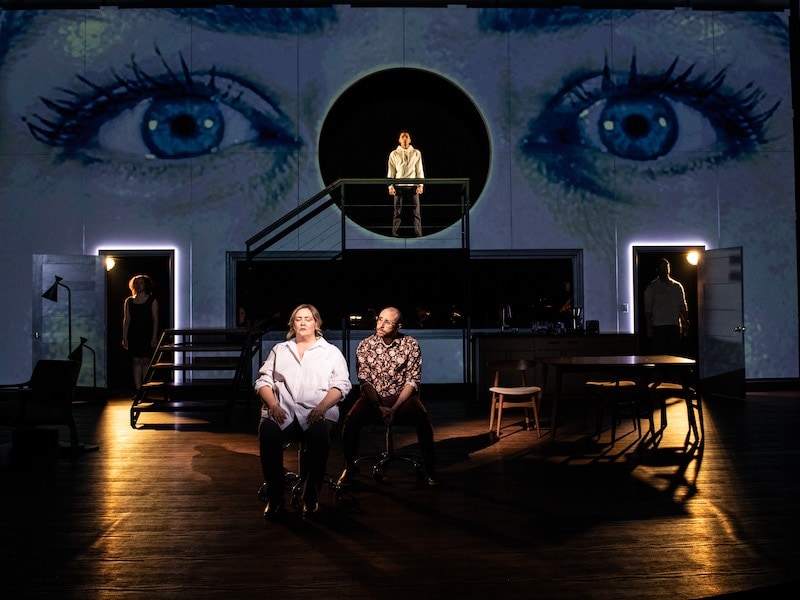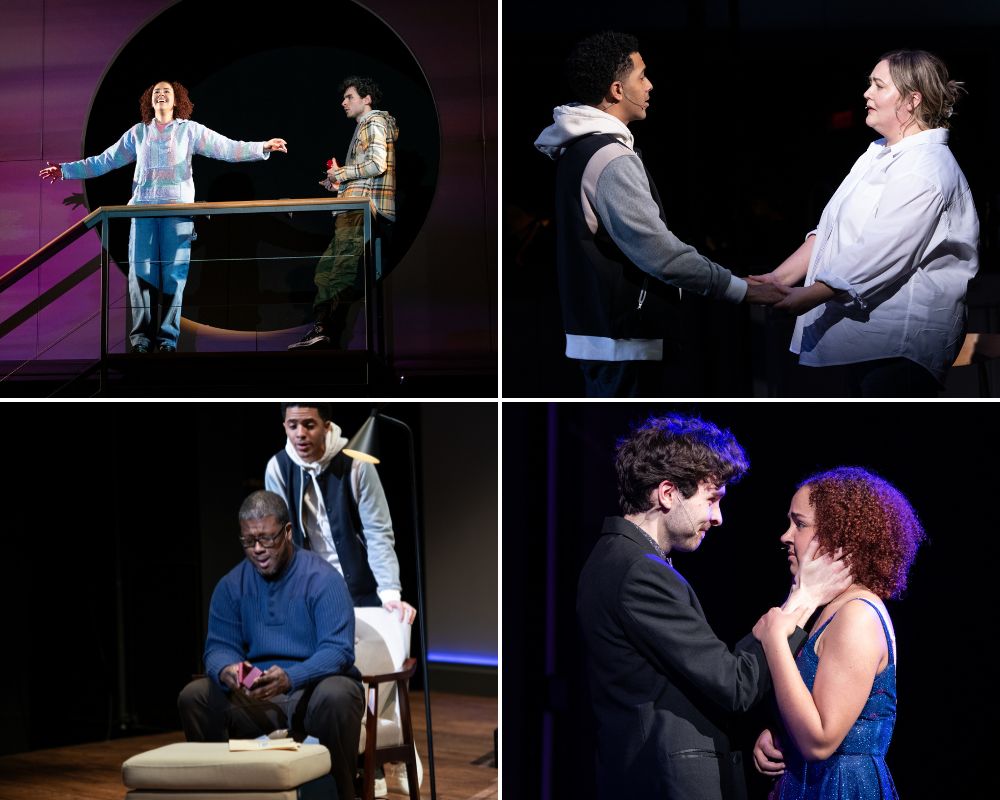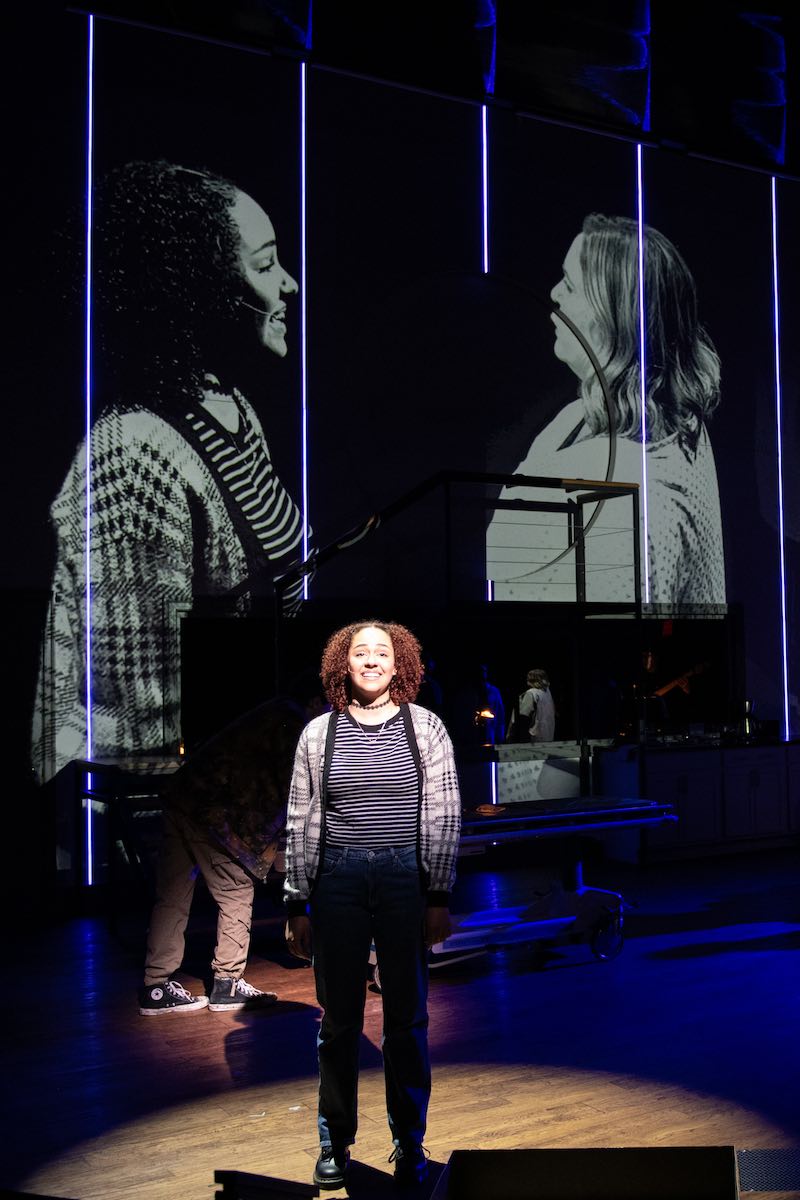Next to nothing is wrong with Round House Theatre’s Next to Normal, a musical masterpiece by Brian Yorkey and Tom Kitt that explores mental illness. Mostly “sung-through,” the Pulitzer- and Tony-winning work — an unblinking peepshow of how a dysfunctional family struggles to function — is rock opera at its finest.
And 15 years after the off-Broadway vehicle shocked DC audiences at Arena Stage on its beeline to Broadway, director Alan Paul allows this electrifying treatment of love, and prescription of how to cope with its predictable loss, the breathing room to vibrate against a modern backdrop of collective anxiety.

Trigger warnings abound, but most Next to Normal devotees find the tableau of a suburban housewife sandwiched between her day-to-day duties and her demons to be a form of therapy, even healing. While only the Goodman family’s matriarch gets strapped with a disease label (a form of bipolar disorder), the rest of the brood bear serious side effects. A self-sacrificing martyr of a husband. A high-achieving daughter whose perfectionism is a means to escape. A spirited son unhealthily close to his mom, a veritable confidant.
But a musical about mental illness, grief, and electroconvulsive therapy? When it comes to dark subjects, humor often lights the way. And jeepers-peepers, the creative artists both on and off stage wring out every ounce of brightness to guide patrons through the emotional wringer. That’s why lighting designer Sherrice Mojgani and projections designer Nicholas Hussong deserve top mention for framing Round House’s off-kilter household.
“Projection” in psychological circles refers to a defense mechanism, when unwanted emotions get tossed in another’s direction, bundled in blame. Thus, Hussong’s exquisite projections, some accomplished in real time with strategically placed cameras, including a haunting aerial view, serve to plumb the inner landscape of each character. It’s a dazzling mind trip. At times, they help externalize memory and illusion. While characters are set in incongruent space and time before our eyes, their live images appear to be having a conversation on his larger-than-life canvas. At one point, Hussong delivers an ode to the original off-Broadway poster/soundtrack album cover, with eyes peering menacingly from a purple haze.
Introspection is writ large. Audiences are welcomed into the Carol Sawyer Stage with a startling projection of Diana’s blinking eyeball superimposed on Wilson Chin’s sparse but functional set. It’s clinically cold — a not-too-cozy reading chair with Rembrandt-patch light, an industrial-style prefab staircase, a safe-for-work coffee station, a squat dinette, and a flush-mounted window befitting a hospital ward, through which the band can be observed and which the actors infiltrate when “outside” the home. Behind that looming eyeball is a suspended portal used for entrances, exits, and scene changes — a circle at times split at its poles like a half-moon, symbolizing the fissure and lunacy within.
Still, much of the magic and mettle in this production, presented in conjunction with Barrington Stage Company, comes from the light board. Mojgani’s inspired designs veer from creating a cage while Diana is in the grips of medical tinkering, to flickering, charging ahead in psychedelic color codes, boxing her in, or fading once balance is restored.

Music director Chris Youstra adds gravitas, yanking at the heartstrings as one of six musicians, mostly on strings, who cushion a worm wheel of feels. Cellist Catherine Mickelson, especially, helps make it hurt so good. Plus, Youstra turns four tenors and two mezzos into a wall of sound driving the sensation that the walls are closing in.
Five of the six onstage actors are making their Round House debuts, but linchpin leads Tracy Lynn Olivera, as mom Diana, and Kevin S. McAllister, as dad Dan — both well known to and beloved by local audiences — simply stun with pristine vocals and wry, wrenching performances.
Olivera’s interpretation of Diana is far less manic than those who have come before, yet she manages to ground the character in a lucid confidence that makes her all the more relatable. Her crystalline enunciation of even the most unsavory lines — one delivered with Groucho Marx flair, and each to be savored — upgrades her from victim to victor. Paul occasionally places her downstage with her back to the audience, as if she is as much observer as we are to a life she feels disconnected from. And goodness, she’s funny. She also makes the genre-bending, countrified “I Miss the Mountains” — which seemed a token spotlight song for originator Alice Ripley — belong by infusing soul.
Diana’s disconnect is respected in Paul’s staging by the distance that Olivera maintains from McAllister throughout. Dan sings “Can I touch you?” and Diana is suitably repelled. Some of their most fevered scenes jettison them in opposing corners — the lack of intimacy enhancing the discomfort of their exchanges.
McAllister is the first Dan this critic has seen who is able to drive home the meaning of the surname “Goodman.” He’s a truly good man who milks his best intentions while exposing the shortcomings of a Mr. Fix-It mindset. “I thought she was better!” he protests, bespeaking not only his deep bewilderment but delusional optimism. Only one thing distracted from McAllister’s ravishing vocals: his having to manipulate, while singing, a bloody garment in what appeared to be an evidence bag — a distasteful, misguided prop.
If one can listen more than look, though, the rapturous rock sustains you. All four tenors are unrivaled in their brilliance. Calvin McCullough, who morphs from Doctor Fine to Doctor Madden (perhaps a commentary by author Yorkey that physicians are indiscernible?), will prick up your ears and induce goosebumps. The talent of Lucas Hinds Babcock (Gabe) is, by leaps and bounds, unreal. You heard it here first: He’s a star in incubation. But it’s Ben Clark as Henry, suitor to Natalie Goodman, who delivered the freshest take for this reviewer. Initially using his hands to great hypnotic effect — beseeching and invading her space — he fleshes out the character from a besotted “stoner” to perfectly memorable. His dramatic and patient pacing in “Hey #3/Perfect for You (Reprise)” proved heart-stopping.

Amid Next to Normal’s unglued milieu, Natalie has always represented the glue. Round House veteran Sophia Early’s Natalie blooms from a non-censored, angst-ridden, rolling-eyes teen to surpassing her parents in wisdom. You can see it in her costume design, by Helen Q. Huang and Becca Janney. Natalie starts out in a geometric quilt-square sweater — equally hip and beyond her years, its ordered pattern like the life she has plotted out and the Mozart music she fervently practices. Over the course of the show, her wardrobe grows disheveled with mixed lines — a chicken-scratch pattern worn over stripes, for instance. Eventually, during a showdown with her mom, their looks mirror each other’s, yet Natalie’s grownup fashion sense hints at a role reversal, while Diana’s garbs, from loungewear to hospital wear, become progressively layered, matching an evolving psyche. (The only costume puzzlement was the doc’s wild-and-crazy-guy outfits — they spoke volumes, but what they were persistently saying seemed unclear.)
Whatever you bring or take from this show, though, shedding skins and, ultimately, light is what it’s all about. The love light in the eyes, a porch light patiently on ’til dawn, the glowing lights of home, a glaring light of truth, the inner light we must tend, and, in our darkest hours, those distant beacons of hope.
If you or someone you know may be experiencing a mental health crisis, contact the 988 Suicide & Crisis Lifeline by dialing or texting “988.” (To reach the Native and Strong Lifeline, call “988” and press 4.)
Running Time: Approximately two hours and 20 minutes, including one intermission.
EXTENDED: Next to Normal plays through March 3, 2024, at Round House Theatre, 4545 East-West Highway, Bethesda, MD. For tickets ($46–$83), call the box office at 240-644-1100 or go online. (Learn more about special discounts here, accessibility here, and Free Play program for students here.)
Performances are Tuesday through Thursday at 7:30 pm, Friday and Saturday at 8:00 pm, and Saturday and Sunday at 2:00 pm.
Audio described performance: Saturday, February 3 at 2:00 pm
Open captioned performance: Saturday, February 10 at 2:00 pm; additional date TBA
The playbill for Next to Normal is online here.
COVID Safety: Round House Theatre no longer requires that audience members wear masks for most performances. However, masks are required for the following performances: Tuesday, February 13 (evening); Saturday, February 17 (matinee).
Next to Normal
Book and lyrics by Brian Yorkey
Music by Tom Kitt
Directed by Alan Paul
Choreographed by Eamon Foley
Co-produced with Barrington Stage Company




